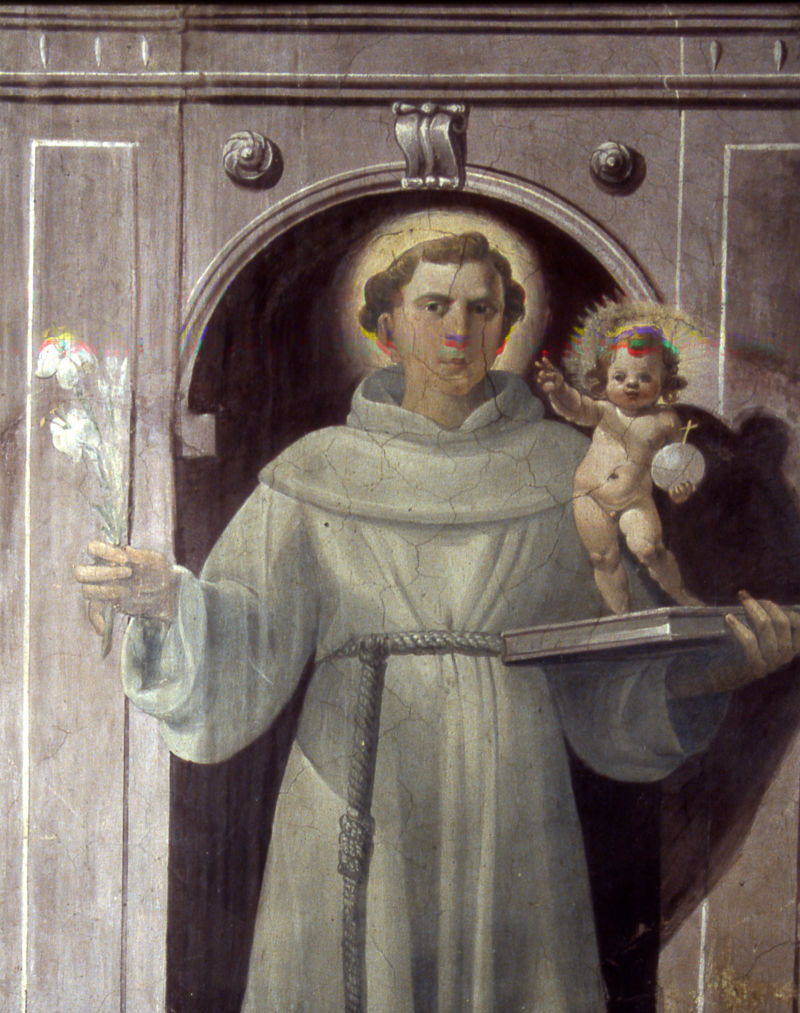Sant'Antonio da Padova

ITA
Raffigurato in piedi entro una nicchia dipinta in corrispondenza del primo registro sulle pareti, accanto ai Padri della Chiesa. Dipinto in abito francescano, con saio e cordone con tre nodi (povertà, castità e obbedienza), reca i suoi attributi iconografici: il libro, il giglio bianco e il Bambino in ricordo della sua apparizione leggendaria. Nato nel 1195 a Lisbona entra nell’ordine dei Canonici Agostiniani a Coimbra e poi a Lisbona. Qui vede i corpi di cinque martiri francescani decapitati in Marocco dove erano stati inviati da Francesco in missione. Colpito da questo evento e affascinato dalla esperienza di fede del nuovo ordine del santo di Assisi si unisce a loro. Si reca in Marocco, ma malato di malaria viene costretto dai fratelli a ritornare a Bologna come lettore in teologia, poi insegna a Montpellier e Tolosa.
Ancora in Italia a Forlì e poi a Padova viene apprezzato per i suoi dotti e appassionati sermoni, tanto che Francesco gli affida il ruolo di predicatore e insegnante per curare l’istruzione dei fratelli e non esser meno dei Domenicani. Padova diviene la sua seconda patria e qui muore nel 1231 e dove, nella cappella del Tesoro della Basilica è conservala la sua lingua incorrotta dopo la morte, come reliquia venerata. Già Gregorio IX nel 1228 lo aveva definito “arca del Testamento” e nel 1946 Papa Pio XII lo proclama “Dottore della Chiesa”.
ENG
Depicted standing in a painted niche corresponding to the first register on the walls, next to the Fathers of the Church. Painted in Franciscan habit, with a habit and a cord with three knots (poverty, chastity and obedience), he bears his iconographic attributes: the book, the white lily and the Child in memory of his legendary apparition. Born in 1195 in Lisbon, he entered the order of the Augustinian Canons in Coimbra and then in Lisbon. Here he saw the bodies of five Franciscan martyrs beheaded in Morocco where they had been sent by Francis on a mission. Struck by this event and fascinated by the experience of faith of the new order of the saint of Assisi, he joined them. He went to Morocco, but sick with malaria, he was forced by his brothers to return to Bologna as a reader in theology, then he taught in Montpellier and Toulouse. Still in Italy in Forlì and then in Padua he is appreciated for his learned and passionate sermons, so much so that Francis entrusts him with the role of preacher and teacher to take care of the education of the brothers and not to be less than the Dominicans. Padua becomes his second homeland and here he dies in 1231 and where, in the chapel of the Treasury of the Basilica his incorrupt tongue is preserved after his death, as a venerated relic. Already Gregory IX in 1228 had defined him as the “ark of the Testament” and in 1946 Pope Pius XII proclaimed him “Doctor of the Church”.
ESP
Representado de pie en una hornacina pintada en correspondencia con el primer registro de las paredes, junto a los Padres de la Iglesia. Pintado con hábito franciscano, con hábito y cordón de tres nudos (pobreza, castidad y obediencia), lleva sus atributos iconográficos: el libro, la azucena blanca y el Niño en memoria de su legendaria aparición. Nacido en 1195 en Lisboa, ingresó en la orden de los canónigos agustinos en Coimbra y luego en Lisboa. Aquí ve los cuerpos de cinco mártires franciscanos decapitados en Marruecos, donde habían sido enviados por Francisco en misión. Impresionado por este acontecimiento y fascinado por la experiencia de fe del nuevo orden, el santo de Asís se une a ellos. Fue a Marruecos, pero enfermo de malaria sus hermanos lo obligaron a regresar a Bolonia como profesor de teología y luego enseñó en Montpellier y Toulouse.
De nuevo en Italia, en Forlì y luego en Padua, fue apreciado por sus sermones eruditos y apasionados, hasta el punto de que Francisco le confió el papel de predicador y maestro para cuidar de la educación de sus hermanos y no ser menos que los dominicos. . Padua se convirtió en su segunda patria y aquí murió en 1231 y donde, en la capilla del Tesoro de la Basílica, se conservó después de su muerte su lengua incorrupta, como reliquia venerada. Gregorio IX ya lo había definido como "arca del Testamento" en 1228 y en 1946 el Papa Pío XII lo proclamó "Doctor de la Iglesia".
